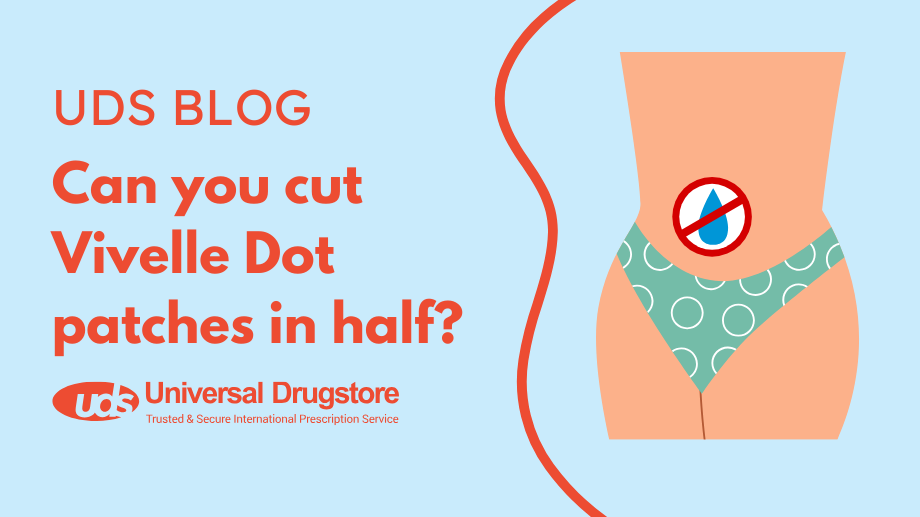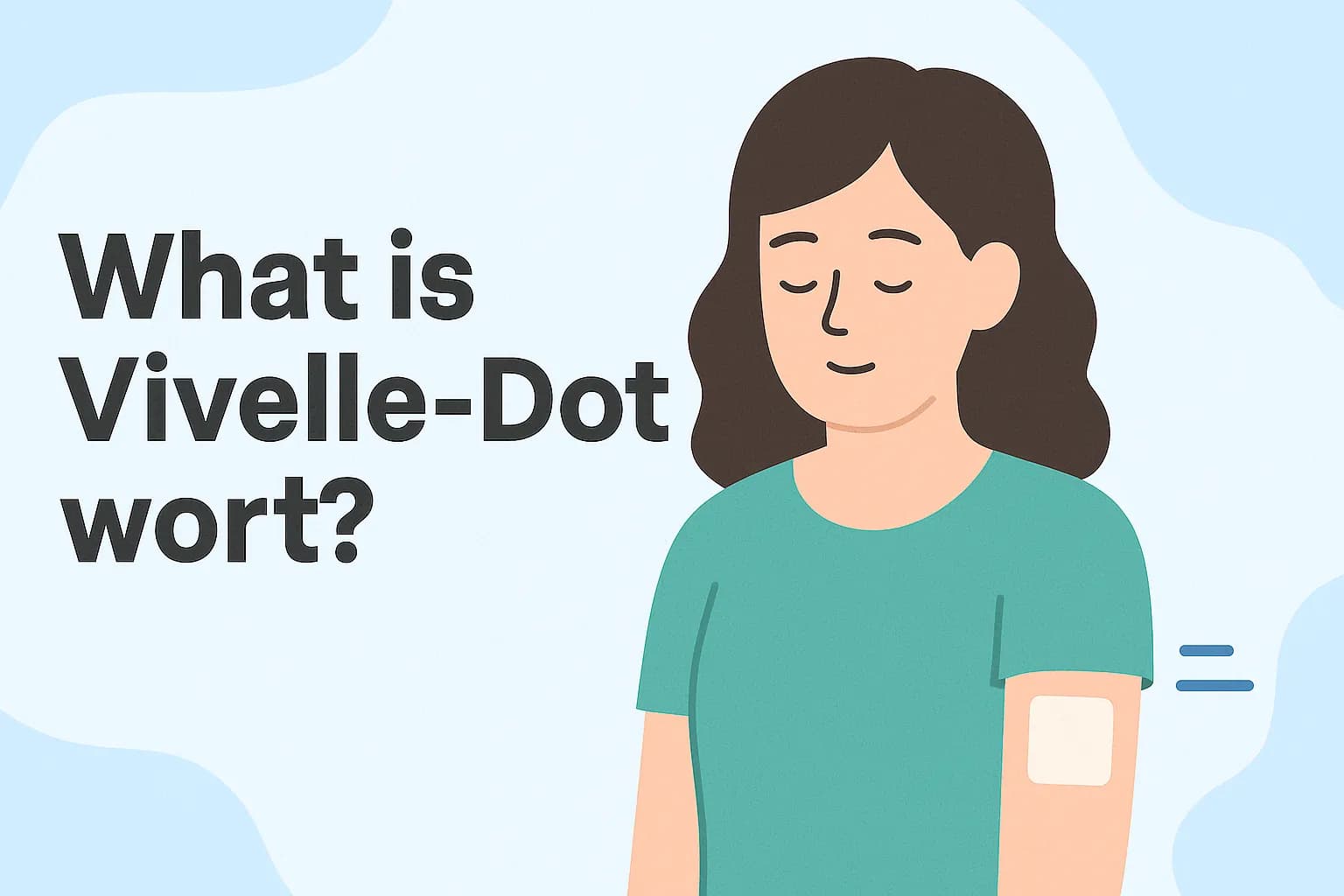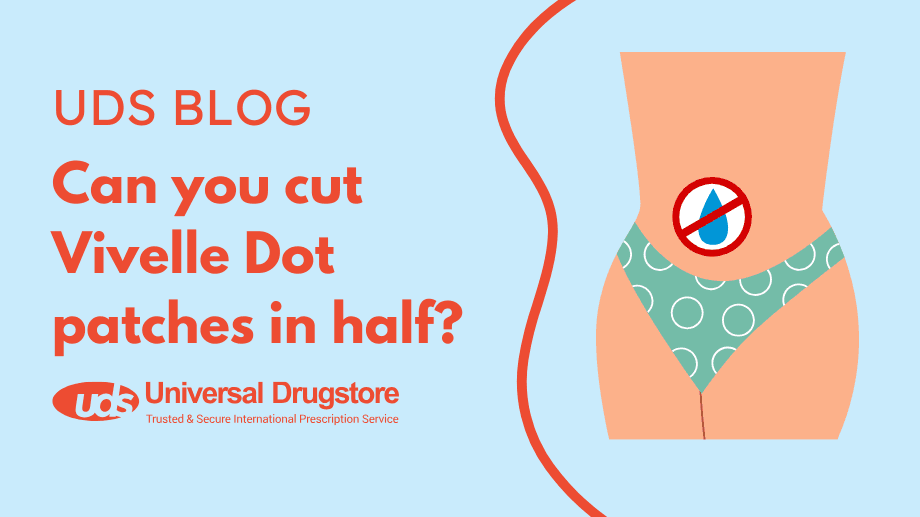Can you cut Vivelle-Dot patches in half?

Can Vivelle-Dot patches be cut in half?
Transdermal patches such as Vivelle-Dot (estradiol) are a convenient form of hormone therapy. There are several advantages to using transdermal patches over oral pills. The medication gets into your body quicker because it skips your digestive system. You may also experience fewer stomach-related side effects such as nausea and vomiting. Transdermal patches are easy to apply and are typically only changed once or twice a week, which means you do not have to remember to take pills each day.
Vivelle-Dot estrogen patches are comprised of three layers: the backing, an adhesive layer containing estradiol, and a protective liner. This system is designed to release estradiol continuously after applying it to your skin. So if you cut the Vivelle-Dot patch, you may damage the layers that make the process work. This can result in all of the medication being released at once and may lead to serious complications.
In general, you should not cut your Vivelle-Dot patch in half. There are no studies on the safety or effectiveness of doing this. The only transdermal patches that are FDA-approved to be cut are lidocaine patches. Used to relieve pain, lidocaine patches are made so you can cut them into smaller pieces.
Vivelle-Dot FAQs
What is Vivelle-Dot used for?
Vivelle-Dot is a transdermal form of hormone replacement therapy (HRT). This brand-name medication is approved by the FDA to increase estrogen levels to treat menopausal symptoms and prevent osteoporosis in postmenopausal women or women who have had a hysterectomy.
What are the side effects of using Vivelle-Dot?
The most common side effects of Vivelle-Dot seen in clinical trials include:
- Headache
- Breast tenderness or pain
- Flu-like symptoms
- Stomach pain
- Fluid retention/swelling
- Body or back pain
- Depression
- Vaginal bleeding or spotting
- Upset stomach
- Weight gain
- Bloating
- Skin redness/irritation at the application site
- Vaginal discharge
- Itching
- Nausea
Other possible side effects of Vivelle-Dot include:
- High blood pressure
- Hot flushes
- Facial hair growth
- Joint pain
- Muscle weakness
- Gas
- Constipation
- Anxiety/nervousness
- Trouble sleeping
- Stuffy nose
- Fungal infections
Rarely, Vivelle-Dot may cause severe side effects such as:
Serious, life-threatening allergic reactions, including anaphylaxis
Symptoms of anaphylaxis may include hives (raised red patches on your skin), skin rash, swelling of your face, lips, tongue, or throat, and shortness of breath. Seek immediate medical attention if you experience any symptoms of a serious allergic reaction.
Increased risk of endometrial cancer
If you have any unusual vaginal bleeding, notify your healthcare provider as this could be a sign of endometrial cancer (cancer of the lining of the uterus). Using Vivelle-Dot for more than a year can increase your risk of this type of cancer. If you still have your uterus, you should also take a progestin medication along with your patch, as this is the best way to prevent this problem.
Increased risk of breast cancer
The longer you take Vivelle-Dot, the higher your risk will be of developing breast cancer. That is why you should use this medication at the lowest dose for the shortest amount of time needed. If members of your family have had breast cancer or if you have ever had breast lumps or an abnormal mammogram, you may need to have breast exams more often.
Blood clots, heart attack, and stroke
Vivelle-Dot can increase your risk of blood clots, which can be very dangerous and lead to a heart attack, a stroke, or a pulmonary embolism (life-threatening blood clot in the lungs). Seek immediate medical attention if you have pain in your legs or arms, chest pain, sudden severe headaches, trouble breathing, or sudden changes in your speech or vision.
Dementia
Women taking medications that contain estrogen, like Vivelle-Dot, might have a higher risk of developing dementia. Your risk is highest if you start using Vivelle-Dot for the first time after age 65.
Gallbladder problems
Vivelle-Dot can cause you to have gallbladder problems and some people have had to have their gallbladder removed after starting this medication. If you experience stomach pain, nausea, or vomiting that doesn’t go away, fever, or a yellowing of the skin and eyes (jaundice), notify your healthcare provider right away.
Pancreatitis
Vivelle-Dot can increase your triglyceride (blood fats) levels, which can cause heart problems or inflammation of your pancreas. Your healthcare provider might order regular blood tests to watch for this while you are using this medication. If you experience sudden stomach or back pain, nausea, vomiting, sudden weight loss, or a fast heart rate, contact your provider or get medical attention right away.
These are not all of the possible adverse events of Vivelle-Dot. You should always seek medical advice from a healthcare professional for any questions or concerns about your medical condition or treatment. You should also read all the patient information, including your Medication Guide that comes with Vivelle-Dot. You can report side effects to the FDA at 1-800-FDA-1088 or www.fda.gov/medwatch.
What does Vivelle-Dot do?
The active ingredient in Vivelle-Dot is estradiol, which is a synthetic form of the estrogen hormone. Estrogen is a female sex hormone produced by the ovaries and is necessary for many processes in the body. Vivelle-Dot replaces estrogen hormones that your body loses during menopause. Replacing estrogen helps prevent bone loss and relieves symptoms of menopause, such as hot flashes and vaginal dryness.
What should you tell your healthcare provider before using Vivelle-Dot?
You should not take this medication if you have an allergy to estradiol or any of the inactive ingredients in this product. You should be sure your healthcare provider is aware of all your medical conditions as they may be contraindications or you may need increased monitoring during treatment, including:
- Any unusual vaginal bleeding
- Cancers such as breast, ovarian, or uterine cancer
- Certain blood disorders such as porphyria
- Blood clotting disorders such as protein C or protein S deficiency
- Heart disease
- Previous heart attack or stroke
- Gallbladder disease
- Kidney disease
- Liver disease
- Hereditary angioedema
- High cholesterol/triglycerides
- Uterine fibroids
- Endometriosis
- Migraine headaches
- Underactive thyroid
- Diabetes
- Seizures
- Asthma
- High calcium levels in your blood
- Pregnant or plan on becoming pregnant
- Breastfeeding or plan to breastfeed
Are there any drug interactions with Vivelle-Dot?
When Vivelle-Dot is taken with other prescription drugs, over-the-counter medications, vitamins, herbal products, and supplements, it may change how they work or increase the risk of side effects. Tell your healthcare provider about all your current medications, including:
- CYP3A4 inducers such as phenobarbital, carbamazepine, rifampin, or St. John’s wort
- CYP3A4 inhibitors such as erythromycin, clarithromycin, ketoconazole, itraconazole, ritonavir, and grapefruit juice
How should you use Vivelle-Dot?
Place the sticky side of the Vivelle-Dot patch on a clean, dry area of the trunk of your body including the buttocks or stomach. This area should be clean, dry, and free of powder, oil, or lotion for your patch to stick to your skin. Do not apply Vivelle-Dot to your breasts and avoid the waistline, as tight clothing can rub the patch off. When applying, hold the patch firmly in place with the palm of your hand for around 10 seconds.
When changing your patch on your twice-a-week schedule, apply the new patch to a different site. Do not apply a new patch to that same area for at least 1 week. If your patch falls off, reapply it or apply a new patch in a different location. Either way, you should continue your original treatment schedule.
What strength does Vivelle-Dot come in?
- 0.025 mg/day
- 0.0375 mg/day
- 0.05 mg/day
- 0.075 mg/day
- 0.1 mg/day
How do you store Vivelle-Dot?
Store Vivelle-Dot patches in their pouch at room temperature between 68°F to 77°F (20°C to 25°C). You should apply the patch as soon as you remove it from its pouch. Used Vivelle-Dot patches still contain estrogen. To dispose of it properly, fold the sticky side of the patch together, place it in a sturdy child-proof container, and place this container in the trash. Used Vivelle-Dot patches shouldn’t be flushed down the toilet.
Does estrogen patch placement matter?
Yes, estradiol patches are typically applied to your low belly or buttock areas. You should try and avoid your waistline as tight clothing may rub it off. Be sure to rotate your application site each time you change your patch. Do not apply a new patch to that same area for at least 1 week to help avoid skin irritation.
Related Medications
- Climara (estradiol patch)
- Climara Pro (estradiol/levonorgestrel)
- Alora Patches (estradiol)
- Estraderm (estradiol)
- Minivelle (estradiol patch)
- Menostar (estradiol)
- Esclim (estradiol)



